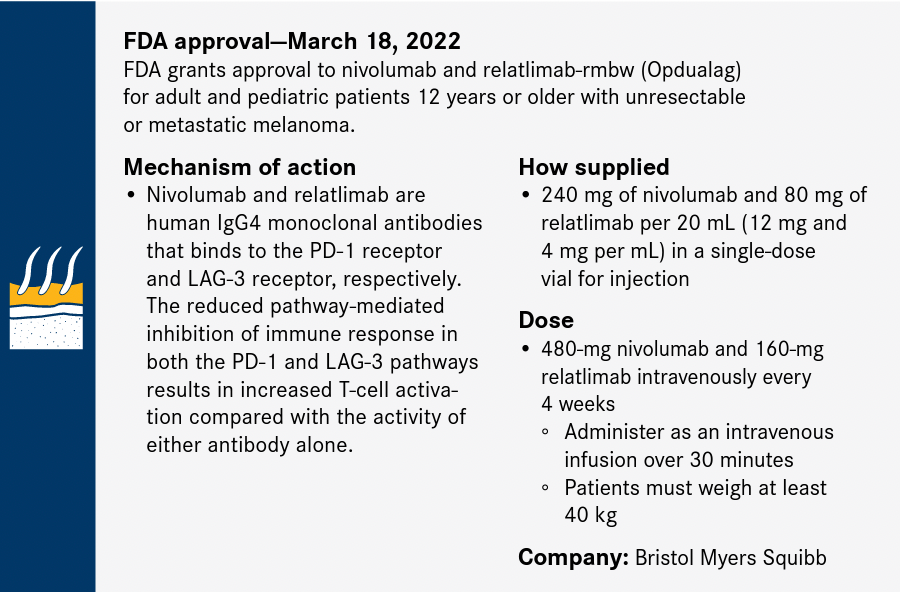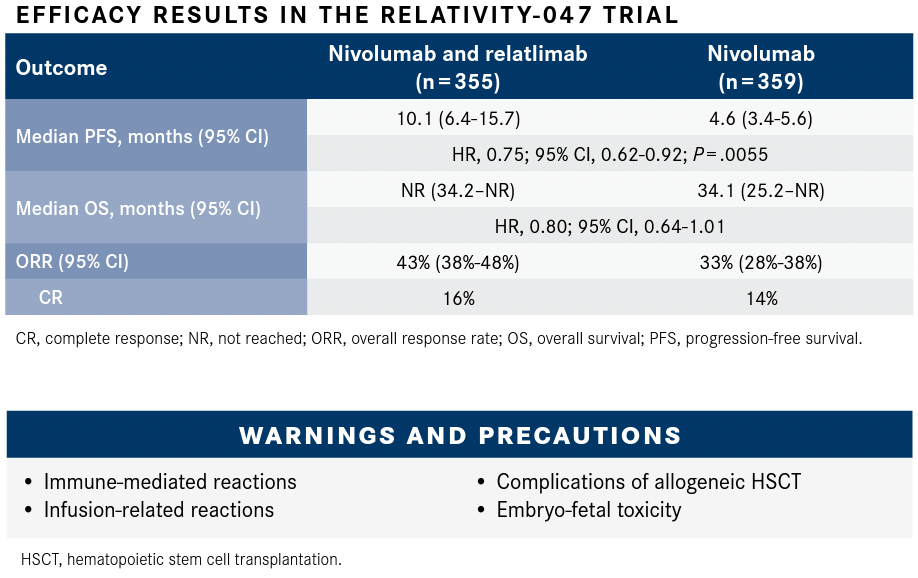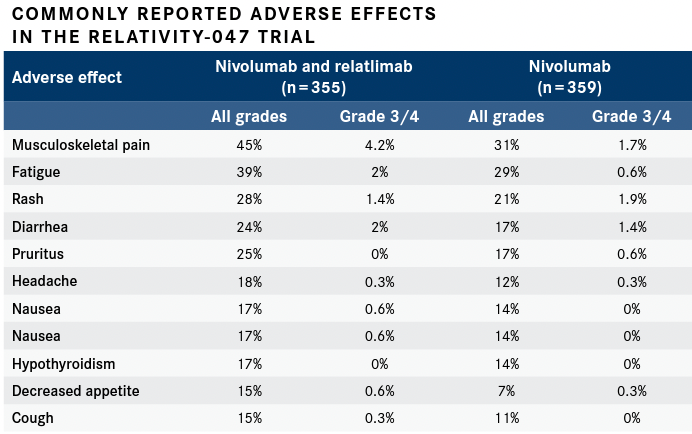Publication
Article
Nivolumab Plus Relatlimab Aims to Become Primary Treatment Option for Advanced Melanoma
Author(s):
The addition of novel anti–LAG-3 antibody relatlimab-rmbw to antiPD-1 antibody nivolumab offers treatment-naïve patients with unresectable or metastatic melanoma an efficacious and tolerable immunotherapy treatment option.
Hussein A. Tawbi, MD, PhD, of MD Anderson Cancer Center

The addition of novel anti–LAG-3 antibody relatlimab-rmbw to antiPD-1 antibody nivolumab offers treatment-naïve patients with unresectable or metastatic melanoma an efficacious and tolerable immunotherapy treatment option. The FDA approved the combination of nivolumab and relatlimab-rmbw (Opdualag) for adult and pediatric patients 12 years or older with unresectable or metastatic melanoma.1
The approval was supported by data from the phase 2/3 RELATIVITY-047 trial (NCT03470922), in which the combination was evaluated among patients with previously untreated metastatic or unresectable stage III or IV melanoma. Patients who received nivolumab and relatlimab (n = 355) experienced a median progression-free survival (PFS) of 10.1 months (95% CI, 6.4-15.7) compared with 4.6 months (95% CI, 3.4-5.6) among the 359 patients who received nivolumab alone (HR, 0.75; 0.62-0.92; P = .0055). Notably, the median overall survival (OS) among patients treated with the combination was not reached (NR; 95% CI, 34.2–NR) vs 34.1 months (95% CI, 25.2–NR) for patients treated with nivolumab monotherapy (HR, 0.80; 95% CI, 0.64-1.01). The overall response rate (ORR) was 43% (95% CI, 38%-48%) and 33% (95% CI, 28%-38%) in the experimental and control groups, respectively.1
In an interview with OncologyLive®, Hussein A. Tawbi, MD, PhD, director of personalized cancer therapy in the Department of Melanoma Medical Oncology in the Division of Cancer Medicine at The University of Texas MD Anderson Cancer Center in Houston, discussed how the combination improves upon the established immunotherapy treatments in melanoma and highlights key treatment takeaways observed with the regimen.
What effect will the approval of nivolumab plus relatlimab have on the melanoma field?
We have known for years now, since the original days of ipilimumab [Yervoy], that checkpoint inhibitors can improve patient survival and can potentially provide longterm benefit for patients with metastatic melanoma. We also know that single-agent PD-1 [inhibitors] have improved efficacy vs single-agent CTLA-4 [inhibitors] and have an improved toxicity profile.
The FDA Approval

We are lucky to have a combination [such as] ipilimumab and nivolumab that is more potent and can offer a better benefit to our patients with metastatic disease, especially patients with brain metastases. We are happy to have an option where the combination seems to offer benefit above and beyond single-agent PD-1 [inhibitors] as shown in the randomized phase 2/3 RELATIVITY-047 trial.
[This benefit] happens at the toll of a small increase in added toxicity [that is] not as staggering as it was with the combination of ipilimumab and nivolumab. The toxicity of nivolumab and ipilimumab is 18.9% compared with approximately 15% with nivolumab alone. We feel this will offer a new option for our patients who were [previously] going to be treated with single-agent nivolumab. It offers us a new combination in our armamentarium that may be used in other settings, as well.
It is remarkable to see that, after a longer follow-up of approximately 19 months, that the benefit and PFS for the nivolumab combination compared with nivolumab alone remains consistent. The HR showed an approximately 25% improvement in PFS. We also have ORR data that shows a significant improvement in their response rate; 43% compared with approximately 30% for single-agent nivolumab.
We’re also seeing a hint of a survival benefit, around a 20% improvement in OS, although it is not yet statistically significant. In a field where the median OS is in the 6-year range, after 19 months of follow-up, it may be early, but we already see that potential [effect] on OS, which is exciting for our patients and clinicians.
That benefit is happening at the expense of only a 3% to 5% increase in immune-related adverse effects [AEs], which is a very modest increase compared with what we’re used to with the combination of ipilimumab and nivolumab, where [we see] almost a 40% increase in grade 3/4 AEs. In terms of the AE profile, it looks very similar to what we see with single-agent nivolumab in terms of pattern and of response to immunosuppressive therapy.
How do you see this approval affecting the treatment paradigm in melanoma?
This approval is going to lead to most of us using the combination any time we [would have previously] considered using single-agent nivolumab. I find it very hard to find a reason to treat a patient without the combination if they are appropriate for [treatment with] single-agent nivolumab.
Efficacy Results

There are still going to be patients [for whom] we will consider the combination of ipilimumab and nivolumab, especially patients with brain metastases. It is a clear situation where we still don’t have data for nivolumab and relatlimab together, which is something we’re hoping to generate [soon]. But there will be situations where the combination of ipilimumab and nivolumab will be used. [For patients with] brain metastases, I would think about the situation where a higher response rate may be required in a patient who is rapidly progressive or symptomatic. There’s still a role for ipilimumab and nivolumab, but I don’t see an ongoing role for single-agent nivolumab.
We looked specifically at whether there is any difference in the subgroup analysis in any population, and the benefit was consistent across all subgroups. Whether patients have LAG-3 positivity or not, that didn’t matter; PD-L1 [status] didn’t matter. Patients who had a higher tumor burden, high LDH [lactate dehydrogenase levels], all of the typical factors that we consider to be [indicative of] higher risk disease, still had a consistent PFS [and] ORR benefit, and a survival advantage.
Is there anything concerning this approval that you would like to emphasize to community oncologists?
This is a 30-minute infusion—a single infusion—for the combination. [This administration] will be helpful for community oncologists to adopt [this therapy] relatively quickly. Again, they [must] remain vigilant for immune-related AEs. Identify [and act on] them early [to] help prevent them from becoming severe toxicities.
Common Adverse Effects

Are there any immune-related AEs clinicians should be aware of?
The iRAE profile for nivolumab and relatlimab seems to be similar to singleagent nivolumab. We see pneumonitis, [and] we see a much lower incidence of colitis [compared with single-agent] ipilimumab or the combination [of ipilimumab and nivolumab]. [We saw] endocrine abnormalities that were similar to single-agent nivolumab—maybe a slight increase in adrenal insufficiency.
Adrenal insufficiency is always challenging to diagnose, [as] it is subtle and develops over time. I would absolutely keep that in mind as one of the potential reasons patients may present with fatigue, lower blood pressure, and other symptoms. Our oncologists, both academic and in the community, have become very familiar with managing iRAEs. This fits well with what we normally do for singleagent PD-1 [inhibitors].









